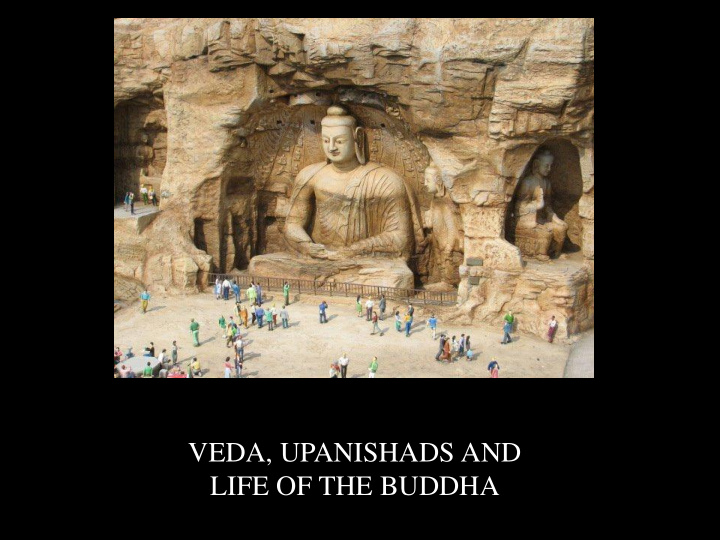



VEDA, UPANISHADS AND LIFE OF THE BUDDHA
RELIGIOUS LANDSCAPE IN 600 B.C.E c. 1500 B.C.E. VEDAS - Natural Forces as Gods Indra – God of Thunder, king of the gods Brahmanaspati /Brahma – God of the Creative Word Surya – Sun God (Mitra, Vishnu – solar gods, sun cult) Agni – God of Fire Varuna – God of Ocean, also solar god Aditi – Mother of the Gods Saraswati – river goddess of inspiration Prithvi – earth goddess - Symbolic language - Caste system – hereditary and hierarchical (brahmin, kshatriya, vaishya, sudra, achyuta)
RELIGIOUS LANDSCAPE IN 500 B.C.E VEDAS (cont’d) c. 1500 B.C.E. - Fire Sacrifices – brahmin mediated offerings of libations, grains and animals - Recognition of practitioners of extremism (Vratyas, Keshins) – ascetic and middle path, shraman and brahmin - Ritual as Icon
RELIGIOUS LANDSCAPE IN 500 B.C.E c. 10 th – UPANISHADS 7 th c. B.C.E. - Vedic reformism; proto-philosophic texts - Concern with ultimate reality as Unitary (Brahman) - Bliss (Ananda) as basis of reality - Idea of self-division of Brahman as an appearance through power of Maya - Individualized self-appearances of Brahman = Atman - Affirmation of reincarnation - Emphasis on experience of Brahman through meditation - Privileging of shramanic/monastic (muni) existence - Freedom from cycle of rebirths (moksha / jivanmukti)
Conception of the Buddha – Maya’s white elephant dream Bharhut Mahastupa, c. 2 nd c. B.C.E.
Birth of Buddha at Lumbini, Gandhara, c. 2 nd c. C.E.
Conception and Birth, Sarnath style, c. 6 th c. C.E
Seer Asita’s prediction, Gandhara, 3 rd – 4 th c. C.E. – play of king and shraman ideas - idea of the philosopher-king
Gautama as a young adult meditating under a jambu tree, Gandhara, c. 6 th c. -Spontaneous meditation - Prelude to his bodhi meditation
Gautama Encounters the Four Signs, Thailand, 20 th c. -old age: suffering as incapacity -sick man: suffering as pain -dead man: -suffering as non- existence -shraman: -seeking for a way out of suffering
Gautama departs from his palace, Gandhara, 4 th c. C.E.
The Great Departure, Abanindranath Tagore, c. 1918 At age 29, Gautama departs on his horse Kanthaka to find the solution to the problem of suffering
Gautama releases his horse and servant and shears his hair, Borobudur, 9 th c. C.E.
From Rajagriha, Gautama studied with two teachers, Arada Kalama and Udaraka Ramaputra. Having mastered their meditation practices, he did not find the answer to his question on eradicating suffering. He joined a band of 5 wandering shramans and came near Uruvela, trying to outdo them in ascetic practices. Gautama as an Ascetic, Gandhara, Sikri Stupa, 1 st . – 3 rd . c. C.E.
Liang Kai. Shakyamuni Descending from the Mountains. Hanging scroll. Ink and color on silk, China, early 13 th c. He remembers his spontaneous meditation and affirms the middle path – a Vedic choice
Gautama is attacked by the hordes of Mara, Mogao cave 428, N. Zhou, 6 th c. C.E.
Gautama reaching Enlightenment, black schist, Nalanda monastery, 10 th – 11 th c. C.E.
Buddha teaches his first sermon, “turning the wheel of the Law (dharmachakra pravartana )”, Sarnath, 5 th c. C.E.
THE FIRST SERMON (DHARMACHAKRA PRAVARTANA – TURNING THE WHEEL OF THE LAW )
Return to Kapilavastu, Rahula becomes a monk, Wat Chiang Man, Chiang Mai, c. 1926 .
Parinirvana of The Buddha, Kongobu-ji, Koyosan, 1086
Recommend
More recommend